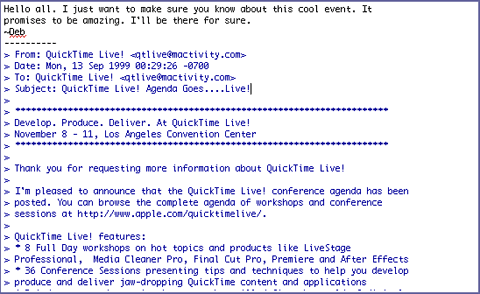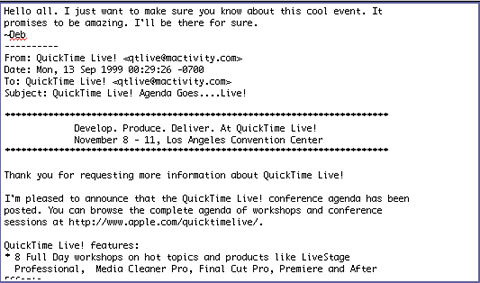|
||||
Email Efficiency PartWritten and published November 10, 1999 Last week we looked at how to format your message replies. This week we look at some more issues pertaining to replying and forwarding e-mail. First lets begin with a comment on one of my recommendations. Alan's point is good and is one that many of us think about. Alan D. Neubert commented:
Message ForwardingHave you ever gotten a message that was forwarded in its entirety, with every line quoted? Personally, this bugs me. The quotes make it harder to read long messages. Quotes have their place, but forwarding is not, in my opinion, one of those places. When you quote a message to reply, you're quoting words already read by you and the other recipients. Forwarded messages have not been read in their original (unquoted) form, so they're harder to read. Here are examples of the two ways you can choose to have your forwarded messages look. Which is easier for you to read?
Do you have a preference as to which you prefer? If so, now's the time to set your own forwarding preferences. It's pretty straightforward.
You get the idea. Quoted adds the quote marks. Whatever you do, please don't choose "as attachment." Unsolicited attachments are annoying and require extra steps. Notice who you're writing to and respect your recipientsHave you ever received a message from someone -- and then been cc'd on a reply or two or fifty as each person who also received the original message replies to the sender and inadvertently replies to everyone else who received the original message? Not cool. When you reply to a message, if you have the option between "Reply" and "Reply All" be sure to choose wisely. Reply sends a reply to the sender only. However, reply all sends your response to every recipient on the list. Even after you hit "Reply" and "Reply All," take the time to look at the to, cc and bcc lines in your reply message. It can save you a lot of embarrassment and it's much more polite to keep other people's addresses private. Along those same lines, if you are bcc'd on a message, it may not be a good idea to reply to the note and advertise that you've received a copy. Consider the situation and honor the sender's considerations. A bcc in e-mail is no different from one on paper, except for it being much more prone to leading to embarrassing situations. Have you ever received a message and seen every single address of every other recipient? That means every one of them knows your e-mail address now. Also not cool. Respect other people's privacy. Don't publish their addresses. Here's a tip to avoid making this mistake:
Along those same lines, if you receive a message that published all recipient's addresses, be decent and remove those names. Be super certain not to forward that note as an attachment because the attachment will include all recipients. (As press and a near-Hollywood resident, because people don't pay attention to how they are sending out e-mail, I have so many emails of so many influential people and movie stars that I bet I could make a fortune selling them by placing tiny ads in the back of newspapers.) Remove excess signatures and tag linesIt's common for messages on e-mail lists to have a few lines of subscription info. But have you ever received a message that had this info quoted, then the same info added again, and quoted, and added again and quoted? It's ridiculous to keep including this info when you know it'll be generated anew. Delete it as you quote. However, if you're forwarding a message, you might keep this info so your recipients know the message's full source. It's really just a matter of logic and consideration of others. The same goes for signatures in lists -- if there's a signature, remove it. Quoting it is annoying -- if someone else has quoted it, remove it. By keeping the proper attribution line, readers can track who's written what. They can also return to each person's original message to see that person's signature lines. There's no need to repeat it, quoting it several times, or quoting several people's signatures. It always strikes me as odd when someone replies to my message and quotes my signature. Don't they know I already know my signature info? Respect a person's words -- this is a biggieEmail is like conversation, but easier to gossip with. When someone tells you something, you tend to respect what's said. Do the same with e-mail. It's very easy to get an e-mail, hit the Forward button and send an entire e-mail on its way to anyone. When a person emails you, consider it a conversation. If it wouldn't be appropriate to quote the person or repeat the conversation then don't forward the e-mail. Words that are in writing have a very long life and you have no control of where they'll end up. Next WeekWe still need to talk about attachments, so I'll be getting to that. Meanwhile, Alan noticed in one of my screen shots that I showed preferences where I left unchecked the Compress Attachments box. Please don't assume from this that I don't compress my attachments. I do. I'll explain my preferences soon. And I hope more of you will share your favorite emoticons and abbreviations with me so I can pass them on to the readers. UNW. (That's "until next week" and I just made it up. Hmmm ... maybe I have a new column signature.) |
||||

